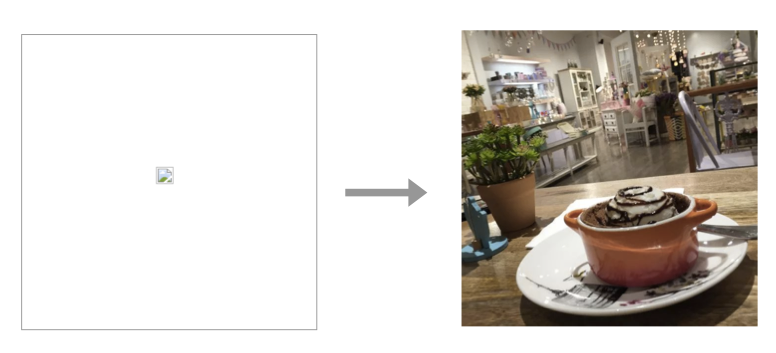Angularjs Failed to Load Resource 403 With Upload
How to handle loading of images that may non exist?
When y'all are treatment millions of images on your website or mobile application, it is quite possible that over a menstruum of time, a few images may end to exist. And when you try to deliver those images on your applications, the users stop upward seeing a cleaved prototype like the 1 below.

Definitely, this is not something that y'all would want showing up on your awarding. There are a few means on how you can fix this broken image trouble to maintain the UX standards of your application.
1. Periodic data cleanup
If an image does not exist, and then it should be removed from the database.
An image URL that is incorrect or points to an paradigm that no longer exists, is well-nigh likely a data issue. So the get-go thing that yous can do to counter the cleaved image problem is to periodically check all images for sanity. Yous would pick up a list of image URLs that have been added over permit'southward say the last calendar week and check if you are able to think those images (a 200 OK HTTP response). If yeah, and then the paradigm stays in your database, else you can discard the paradigm.
Advantages — Solves the problem at the root level. 1-time effort in writing the script
Disadvantages — Lengthy execution times (nearly impossible) for millions of images, waste matter of network bandwidth and cannot catch errors for the time between two consecutive runs of the cleanup task.
2. Handle information technology in your application
If an image does not exist, nosotros can supervene upon information technology with a new 1.
Another mode to handle this outcome is by listening to the mistake event that gets fired when the epitome fails to load. In HTML, this tin be washed with the onerror aspect of the <img> tag.
<img src="http://example.com/non-existent-image.jpg" onerror="this.onerror=null;this.src='http://case.com/real-epitome.jpg';" /> If the original epitome fails to load, then it is replaced past the image mentioned in the onerror attribute handler. Like handling can be done in mobile apps as well.
Advantages — Can handle data issues in real-time, no need for periodic checks
Disadvantages — Won't work for images loaded as groundwork (at least for websites). Problems may continue in older versions of your website or application that cannot be updated with the new code. Different code for different platforms.
3. Handle it on your prototype server
If the prototype does not exist, then the server should not send the error at all.
Your image server knows if an paradigm does non exist and sends a 404 Not Found HTTP status code to the client. Instead, the server itself could replace it with a default epitome, correct the HTTP status code and then send it to the browser or the awarding.
Advantages— Works in existent time without any periodic checks. No handling needed on whatever application or any version of whatsoever awarding. Works for all kinds of images
Disadvantages — Y'all need to build a server that can handle this rerouting for you. Difficult, if not impossible, to get it working with simple image delivery setups like CDN + S3 storage.
iv. Handle it using a third-party image server like ImageKit.io
ImageKit.io automatically provides server-side handling of not-real images. Using ImageKit'southward URL-based transformations, y'all tin can specify the default image that should be delivered, if the original image does non exist, with the original image URL itself. To requite an example,
<!-- The non-existent image URL -->
<img src="https://ik.imagekit.io/demo/img/non_existent_image.jpg" /> <!-- Specifying the default image to be displayed in the URL -->
<img src="https://ik.imagekit.io/demo/img/tr:di-medium_cafe_B1iTdD0C.jpg/non_existent_image.jpg" />
The default image is specified using the di- parameter in the URL. In this case, the default image is from a cafe.

Beingness a URL-transformation, this gives y'all the flexibility to specify a different default image for different kinds of images without having to write any code to handle the mistake cases. You tin can read more about handling of non-existent images or default images using ImageKit here.
Considerations for image caching in mistake cases
Default images sent instead of a non-existent image should not be cached at all or if information technology is cached, and so the enshroud duration should exist pocket-sized, preferably a few hours. This leaves an opportunity for the non-existent image to exist "stock-still" or made available. When this happens, then the correct prototype would starting time getting delivered to the users automatically. However if the image is not expected to be stock-still, then the cache elapsing can be longer.
Considerations for response code in error cases
If yous wish to handle the error case in your application, and so the epitome request should be returned with a 404 status code for the onerror to work. If you are delivering the default prototype instead of a broken image from the server, then the response lawmaking tin can be 302 Temporarily Moved (ideally to forbid caching on intermediate layers like CDN but handling with success and fault handlers in application is impaired) or 200 OK (caching on intermediate layers can exist controlled with caching headers)
Since images form a critical part of our application, ensuring that the UX is not cleaved because of data issues with images is every bit important. I promise the to a higher place techniques will help in ensuring a better experience for your users on your website and app.
Please share if y'all take any other ideas around handling images that no longer exist on a web application.
Source: https://blog.imagekit.io/how-to-handle-loading-images-that-may-not-exist-on-your-website-92e6c3c6ea63
0 Response to "Angularjs Failed to Load Resource 403 With Upload"
Post a Comment